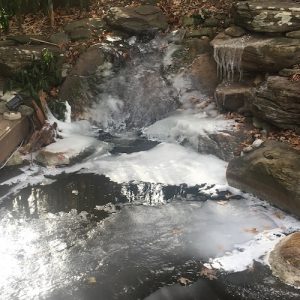Is Your Garden Pond Ready for Winter?
Part 2
By Albert V. Short, Fairfax Master Gardener Intern
A garden pond is like a perennial bed as they both have an annual cycle. You wake it up in the spring and enjoy it during the summer. Now is the time to get your garden pond ready for the approaching winter. Where do you start?
 Inspect the pond structure. If you have a rubber or plastic liner or concrete pond, check for leaks or cracks in the structure and make any repairs while the weather is warm. If it’s a lined pond, check the edge for depressed areas where it can leak. Mid-winter repairs are no fun!
Inspect the pond structure. If you have a rubber or plastic liner or concrete pond, check for leaks or cracks in the structure and make any repairs while the weather is warm. If it’s a lined pond, check the edge for depressed areas where it can leak. Mid-winter repairs are no fun!
How do you winterize a pond pump system? Examine the plumbing pipes. If they are exposed, drain them to prevent freeze damage. If you elect to run the pump all winter and have exposed pipes, a power loss could result in broken pipes and a total water loss.
Fish are cold-blooded, and they become less active and hibernate as the water temperature drops. Stop feeding fish when water temperature goes below 55 degrees F. In the Washington DC area that’s usually in November. A pond over 18 inches deep is usually safe for fish to winter over.
How is debris removed from a pond? It’s easy to clean debris out of the pond if you can pump the water into a holding tank. Lacking a holding tank, the best solution is to net out as much debris as possible. By removing debris nitrogen generation is decreased. During the winter nitrogen gases can kill fish, and it will feed an algae bloom in the spring. Usually, because of cleaning the pond, you will have to add water. Remember to use a dechlorination compound to make the water “fish safe.” Also watch the water temperature. If you are moving fish from one container to another or adding a large amount of new water, more than a 5-degree F difference in temperature can kill fish. See previous article on water dechlorination and temperature, Pond Water Quality – Water Balance and Sources.
Decaying vegetative debris produces nitrogen and other gasses that can kill fish if the pond is frozen. A small area in the ice must be kept open to permit these gases to vent off. The following are ways to vent gases:
- Turn your waterfall pump down to a low level.
- Place a small pump or aeration device on the bottom of the pond to bring warmer water up to the surface.
- Install a deicer, which is a thermostatically controlled device, that turns on when water temperature gets about 35 degrees F and it will keep an area ice free.
 Aquatic plants that have been flourishing during the season need to be cut back and stored for the winter. If they are not tropical, cut them back, and put the pots in the deepest part of the pond. They will winter over, and most will survive. Tropical lilies or other tropical plants are always problematic in this climate. Either put them inside in a warm location or take a chance and put them in the bottom of the pond, and hope they survive. The worst result is they die and next season you must buy a new tropical. This is not the time to repot and fertilize your aquatic plants. Do that in the spring.
Aquatic plants that have been flourishing during the season need to be cut back and stored for the winter. If they are not tropical, cut them back, and put the pots in the deepest part of the pond. They will winter over, and most will survive. Tropical lilies or other tropical plants are always problematic in this climate. Either put them inside in a warm location or take a chance and put them in the bottom of the pond, and hope they survive. The worst result is they die and next season you must buy a new tropical. This is not the time to repot and fertilize your aquatic plants. Do that in the spring.
Cleaning and preparing a pond for winter sets it up for an effective start the next season. In the spring, when the aquatic plants become active and the fish come out of hibernation, you will start another yearly cycle of enjoying your garden pond.
Reference
Frequently Asked Questions, Customer Service, Fairfax Water